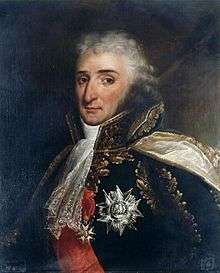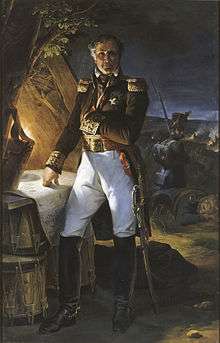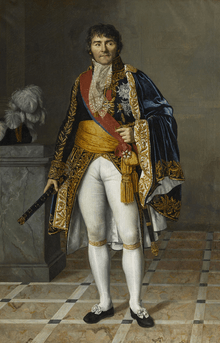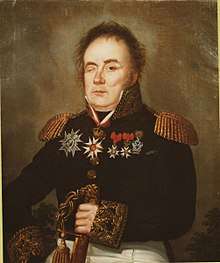VII Corps (Grande Armée)
The VII Corps of the Grande Armée was a French military unit that existed during the Napoleonic Wars. It was formed in 1805 and assigned to Marshal Pierre Augereau. From 1805 to 1807, Augereau led the VII Corps in the War of the Third Coalition and the War of the Fourth Coalition. It was disbanded after being nearly wiped out at the Battle of Eylau in February 1807 and its surviving troops were distributed to other corps. At the end of 1808, the VII Corps was reconstituted in Catalonia during the Peninsular War and General Laurent Gouvion Saint-Cyr was given command of it. The corps fought in Spain until 1811, when it was renamed the Army of Catalonia. At that time it was again led by Augereau.
| VII Corps | |
|---|---|
| Active | 1805–1814 |
| Country | |
| Branch | Army |
| Type | Corps |
| Size | 2-6 infantry divisions plus cavalry |
| Engagements | War of the Third Coalition War of the Fourth Coalition Peninsular War War of the Fifth Coalition War of the Sixth Coalition |
| Commanders | |
| Notable commanders | Pierre Augereau François Joseph Lefebvre Nicolas Oudinot Jean Reynier Laurent Gouvion Saint-Cyr |
A parallel VII Corps was created for the War of the Fifth Coalition in 1809 and assigned to Marshal François Joseph Lefebvre. This formation was entirely made up of troops from Bavaria. In 1812, a new VII Corps composed of soldiers from Saxony was created for the invasion of Russia and General Jean Reynier took command. This formation survived to fight during the War of the Sixth Coalition, but ceased to exist after the Battle of Leipzig in October 1813 due to the defection of the Saxons. The VII Corps was recreated during the 1814 campaign in France and assigned to Marshal Nicolas Oudinot. The formation consisted of one Young Guard division and two regular divisions of Peninsular War veterans.
Order of battle
October 1806

Marshal Pierre Augereau (17,672, 36 guns)[1]
- Chief of Staff: General of Brigade Claude Marie Joseph Pannetier
- 1st Division: General of Division Jacques Desjardin (8,242, 8 guns)
- Brigade: General of Brigade Pierre Belon Lapisse
- 16th Light Infantry Regiment, 1st, 2nd, 3rd, and 4th battalions
- Brigade: General of Brigade Jacques Lefranc
- 14th Light Infantry Regiment, 2nd battalion
- 44th Line Infantry Regiment, 1st, 2nd, and 3rd battalions
- 105th Line Infantry Regiment, 1st, 2nd, and 3rd battalions
- Artillery: Two 12-pound guns, four 6-pound guns, two 6-inch howitzers
- 3rd Foot Artillery Regiment, 4th company
- 6th Horse Artillery Regiment, 2nd company (-)
- Brigade: General of Brigade Pierre Belon Lapisse
- 2nd Division: General of Division Étienne Heudelet de Bierre
- Brigade: General of Brigade François Pierre Joseph Amey
- 7th Light Infantry Regiment, 1st, 2nd, and 3rd battalions
- Brigade: General of Brigade Jacques Thomas Sarrut
- 24th Line Infantry Regiment, 1st, 2nd, and 3rd battalions
- 63rd Line Infantry Regiment, 1st and 2nd battalions
- Brigade: unknown
- Hesse-Darmstadt Fusilier Regiment, 1st and 2nd battalions
- Nassau Infantry Regiment, 3rd battalion
- Artillery: Two 12-pound guns, four 6-pound guns, two 6-inch howitzers
- 3rd Foot Artillery Regiment, 3rd company
- 6th Horse Artillery Regiment, 2nd company (-)
- Brigade: General of Brigade François Pierre Joseph Amey
- Cavalry Brigade: General of Brigade Antoine Jean Auguste Durosnel (1,290, 4 guns)
- 7th Chasseurs-à-Cheval Regiment, 1st, 2nd, 3rd, and 4th squadrons
- 20th Chasseurs-à-Cheval Regiment, 1st, 2nd, and 3rd squadrons
- 6th Horse Artillery Regiment, 5th company, four 4-pound guns
- Corps Artillery: unknown commander (1,323 gunners and train)
- Four 12-pound guns, 12 8-pound guns, four 4-pound guns, four 6-inch howitzers
- 1st Foot Artillery Regiment, 9th, 10th, 11th, and 12th companies
- 2nd Horse Artillery Regiment, 1st and 5th companies
November 1808

General of Division Laurent Gouvion Saint-Cyr (42,382)[2]
- 1st Division: General of Division Joseph Chabran
- 2nd Line Infantry Regiment (1 battalion)
- 7th Line Infantry Regiment (2 battalions)
- 10th Line Infantry Regiment (1 battalion)
- 37th Line Infantry Regiment (1 battalion)
- 56th Line Infantry Regiment (1 battalion)
- 93rd Line Infantry Regiment (1 battalion)
- 2nd Swiss Infantry Regiment (1 battalion)
- 2nd Division: General of Division Giuseppe Lechi
- 2nd Italian Line Infantry Regiment (1 battalion)
- 4th Italian Line Infantry Regiment (1 battalion)
- 5th Italian Line Infantry Regiment (1 battalion)
- Italian Chasseurs Infantry Regiment (1 battalion)
- 1st Neapolitan Line Infantry Regiment (2 battalions)
- 3rd Division: General of Division Honoré Charles Reille
- 32nd Light Infantry Regiment (1 battalion)
- 16th Line Infantry Regiment (1 battalion)
- 113th Line Infantry Regiment (2 battalions)
- Provisional Infantry Regiment of Perpignan (4 battalions)
- 5th Legion of the Reserve (1 battalion)
- Chasseurs de Montagne (1 battalion)
- Battalion of the Valais (1 battalion)
- 4th Division: General of Division Joseph Souham
- 1st Light Infantry Regiment (3 battalions)
- 3rd Line Infantry Regiment (1 battalion)
- 7th Line Infantry Regiment (2 battalions)
- 42nd Line Infantry Regiment (3 battalions)
- 67th Line Infantry Regiment (1 battalion)
- 5th Division: General of Division Domenico Pino
- 1st Italian Light Infantry Regiment (3 battalions)
- 2nd Italian Light Infantry Regiment (3 battalions)
- 4th Italian Line Infantry Regiment (2 battalions)
- 5th Italian Line Infantry Regiment (1 battalion)
- 6th Italian Line Infantry Regiment (3 battalions)
- 7th Italian Line Infantry Regiment (1 battalion)
- 6th Division: General of Division Louis François Jean Chabot
- Chasseurs de la Pyrenees Orientales (1 battalion)
- 2nd Neapolitan Line Infantry Regiment (2 battalions)
- Corps Cavalry:
- Brigade: General of Brigade Bertrand Bessières
- 3rd Provisional Cuirassier Regiment
- 3rd Provisional Chasseurs-à-Cheval Regiment
- Brigade: General of Brigade François Xavier de Schwarz
- Prince Royal Italian Chasseurs-à-Cheval Regiment
- 2nd Neapolitan Chasseurs-à-Cheval Regiment
- Brigade: General of Brigade Jacques Fontane
- Royal Italian Chasseurs-à-Cheval Regiment
- 7th Italian Dragoon Regiment
- Unattached:
- 24th Dragoon Regiment
- Brigade: General of Brigade Bertrand Bessières
April 1809

Marshal François Joseph Lefebvre[3]
- Artillery Reserve: Colonel Calonge
- Three 12-pound position batteries, 18 guns
- 1st Bavarian Division: General-Leutnant Crown Prince Ludwig of Bavaria
- Brigade: General-Major Rechberg
- 1st Habermann Light Battalion
- Leib Regiment (2 battalions)
- 2nd Prince Royal Regiment (2 battalions)
- Brigade: General-Major Stengel
- 4th Salern Regiment (2 battalions)
- 8th Duc Pius Regiment (2 battalions)
- Cavalry Brigade: General-Major Zandt
- Minuzzi Dragoon Regiment (2 squadrons)
- Prince Royal Chevau-léger Regiment (4 squadrons)
- Artillery: Two 6-pound foot batteries, 6-pound horse battery, 18 guns
- Brigade: General-Major Rechberg
- 2nd Bavarian Division: General-Leutnant Karl Philipp von Wrede
- Brigade: General-Major Minuzzi
- 6th Laroche Light Battalion
- 3rd Prince Karl Regiment (2 battalions)
- 13th Regiment (2 battalions)
- Brigade: General-Major Beckers
- 6th Duc Wilhelm Regiment (2 battalions)
- 7th Löwenstein Regiment (2 battalions)
- Cavalry Brigade: General-Major Preysing
- König Chevau-léger Regiment (4 squadrons)
- Leiningen Chevau-léger Regiment (4 squadrons)
- Artillery: Two 6-pound foot batteries, 6-pound horse battery, 18 guns
- Brigade: General-Major Minuzzi
- 3rd Bavarian Division: General-Leutnant Bernhard Erasmus von Deroy
- Brigade: General-Major Siebein
- 5th Buttler Light Battalion
- 9th Isenburg Regiment (2 battalions)
- 10th Juncker Regiment (2 battalions)
- Brigade: General-Major Vincenti
- 7th Günter Light Battalion
- 5th Regiment (2 battalions)
- 14th Preysing Regiment (2 battalions)
- Cavalry Brigade: General-Major Seydewitz
- Taxis Dragoon Regiment (4 squadrons)
- Bubenhoven Chevau-léger Regiment (4 squadrons)
- Artillery: Two 6-pound foot batteries, 6-pound horse battery, 18 guns
- Brigade: General-Major Siebein
January 1810
Marshal Pierre Augereau (1,338 officers, 33,145 men present for duty, 1,172 detached, 15,250 sick)[4]
- Artillery, Train, Engineers: (44 officers, 1,346 men)
- 1st Division: General of Division Joseph Souham (169 officers, 5,213 men)
- 1st Light Infantry Regiment (3 battalions)
- 42nd Line Infantry Regiment (3 battalions)
- 3rd Light Infantry Regiment (1 battalion)
- 7th Line Infantry Regiment (2 battalions)
- 93rd Line Infantry Regiment (1 battalion)
- 24th Dragoon Regiment
- 3rd Provisional Chasseurs-à-Cheval Regiment
- 2nd Division: General of Division Domenico Pino (238 officers, 6,326 men)
- 1st Italian Light Infantry Regiment (2 battalions)
- 2nd Italian Light Infantry Regiment (2 battalions)
- 4th Italian Line Infantry Regiment (2 battalions)
- 5th Italian Line Infantry Regiment (2 battalions)
- 6th Italian Line Infantry Regiment (2 battalions)
- 7th Italian Line Infantry Regiment (1 battalion)
- Napoleone Italian Dragoon Regiment
- 3rd Division: General of Division Jean-Antoine Verdier (334 officers, 6,009 men)
- This division included the remnants of the divisions of Generals of Division Annet Morio de L'isle and Giuseppe Lechi after the Siege of Gerona.
- 32nd Light Infantry Regiment (1 battalion)
- 2nd Line Infantry Regiment (1 battalion)
- 16th Line Infantry Regiment (1 battalion)
- 56th Line Infantry Regiment (1 battalion)
- 1st Neapolitan Line Infantry Regiment (2 battalions)
- 2nd Neapolitan Line Infantry Regiment (2 battalions)
- 2nd Westphalian Line Infantry Regiment (2 battalions)
- 3rd Westphalian Line Infantry Regiment (2 battalions)
- 4th Westphalian Line Infantry Regiment (2 battalions)
- 1st Berg Line Infantry Regiment (2 battalions)
- 2nd Berg Line Infantry Regiment (2 battalions)
- Würzburg Line Infantry Regiment (2 battalions)
- Valais Line Infantry Regiment (1 battalion)
- Ducal Saxon Line Infantry Regiment (1 battalion)
- La Tour d'Auvergne Line Infantry Regiment (1 battalion)
- 2nd Neapolitan Chasseurs-à-Cheval Regiment
- 4th Division: General of Division Guillaume Philibert Duhesme (240 officers, 5,971 men)
- 7th Line Infantry Regiment (2 battalions)
- 37th Line Infantry Regiment (1 battalion)
- 112th Line Infantry Regiment (1 battalion)
- 2nd Swiss Infantry Regiment (one battalion)
- 5th Italian Line Infantry Regiment (2 battalions)
- Chasseurs de Montagne (1 battalion)
- Departmental Battalion (1 battalion)
- 3rd Provisional Cuirassier Regiment
- Other:
- Headquarters: 67th Line Infantry Regiment (1 battalion) (17 officers, 527 men)
- Drafts en route: (32 officers, 1,608 men)
- Drafts in Perpignan: (127 officers, 6,125 men)
August 1812

General of Division Jean Reynier (15,008 infantry in 18 battalions, 2,186 cavalry in 16 squadrons)[5]
- Artillery: 50 guns
- 21st Division (Saxon): General-Leutnant Karl Christian Erdmann von Le Coq[6]
- 1st Brigade: General-Major von Steindel
- Liebenau Grenadier Battalion (1 battalion)
- Prinz Friedrich Infantry Regiment (2 battalions)
- Prinz Clemens Infantry Regiment (2 battalions)
- 2nd Brigade: General-Major von Nostitz
- Prinz Anton Infantry Regiment (2 battalions)
- 1st Light Infantry Regiment (2 battalions)
- Cavalry Brigade: General-Major von Gablenz
- Prinz Clemens Uhlan Regiment (4 squadrons)
- Polenz Chevau-léger Regiment (4 squadrons)
- 1st Brigade: General-Major von Steindel
- 22nd Division (Saxon): General-Leutnant von Funck
- 2nd Brigade: General-Major von Sahr
- Anger Grenadier Battalion (1 battalion)
- Spiegel Grenadier Battalion (1 battalion)
- 2nd Light Infantry Regiment (2 battalions)
- 1st(?) Brigade: General-Major von Klengel[7]
- König Infantry Regiment (2 battalions)
- Niesemeuschel Infantry Regiment (1 and a half battalions)
- 2nd Brigade: General-Major von Sahr
- 32nd Division (French): General of Division Pierre François Joseph Durutte[8]
- 35th Line Infantry Regiment (2 battalions)
- 131st Line Infantry Regiment (3 battalions)
- 132nd Line Infantry Regiment (3 battalions)
- 133rd Line Infantry Regiment (1 battalion)
- Belle-Isle Infantry Regiment (3 battalions)
- Würzburg Infantry Regiment (3 battalions)
October 1813

General of Division Jean Reynier (12,837, 48 guns)[9]
- Corps Artillery:
- One Saxon foot artillery battery (6 12-pound guns)
- One French foot artillery battery (6 12-pound guns)
- One Saxon horse artillery battery (4 guns)
- 13th Division (French): General of Division Armand Charles Guilleminot
- Brigade: General of Brigade Antoine Gruyer
- 1st Light Infantry Regiment (4 battalions)
- 18th Light Infantry Regiment (1st and 2nd Battalions)
- 7th Line Infantry Regiment (3rd Battalion)
- 156th Line Infantry Regiment (1st and 2nd Battalions)
- Brigade: General of Brigade Louis-Francois, Baron Lejeune
- 52nd Line Infantry Regiment (3rd Battalion)
- 67th Line Infantry Regiment (3rd Battalion)
- 101st Line Infantry Regiment (2nd and 3rd Battalions)
- Illyrian Infantry Regiment (2nd Battalion)
- Artillery: One foot artillery battery (6 guns)
- Brigade: General of Brigade Antoine Gruyer
- 24th (Saxon) Division: General-Leutnant von Zeschau
- 1st Brigade: Oberst von Brause
- Lecoq Light Infantry Regiment (1 battalion)
- Spiegel Grenadier Battalion Nr. 1 (1 battalion)
- Prinz Friedrich August Line Infantry Regiment (1 battalion)
- Rechten Line Infantry Regiment (1 battalion)
- Steindel Line Infantry Regiment (1 battalion)
- 2nd Brigade: General-Major von Ryssel
- Sahr Light Infantry Regiment (1 battalion)
- Anger Grenadier Battalion Nr. 2 (1 battalion)
- Niesemueschel Line Infantry Regiment (1 battalion)
- Prinz Anton Line Infantry Regiment (1 battalion)
- Feldjager company
- Artillery: Two foot artillery batteries (16 guns)
- 1st Brigade: Oberst von Brause
- 32nd Division (French): General of Division Pierre François Joseph Durutte
- Brigade: General of Brigade Marie Jean Baptiste Urbain Devaux
- 35th Light Infantry Regiment (1st Battalion)
- 131st Line Infantry Regiment (3rd Battalion)
- 132nd Line Infantry Regiment (3rd Battalion)
- Brigade: General of Brigade Antoine Anatole Gedeon Jarry
- 36th Light Infantry Regiment (4th Battalion)
- 133rd Line Infantry Regiment (3rd Battalion)
- Würzburg Infantry Regiment (3rd Battalion)
- Artillery:
- One foot artillery battery (6 guns)
- One horse artillery battery (6 guns)
- Brigade: General of Brigade Marie Jean Baptiste Urbain Devaux
- 27th (Saxon) Light Cavalry Brigade: Oberst von Lindenau
- Hussar Regiment (8 squadrons)
- Prinz Clemens Uhlan Regiment (5 squadrons)
- One horse artillery battery (4 guns)
Notes
- Chandler (2005), 37
- Oman (2010), I, 647-648
- Bowden & Tarbox (1980), 61-62
- Oman, III, 536-537. All subsequent strengths represent those present for duty.
- Chandler (1966), 1112. This authority listed totals only.
- Smith (1998), 385. This source gave the order of battle for Gorodeczna on 12 August.
- Smith (1998), 382. This 3,500-man brigade was captured at Kobryn on 27 July. By deduction, it must have been the 1st Brigade of 22nd Division.
- Smith (1998), 402. Durutte's division was attached from IX Corps and fought at Wolkowysk on 14–16 November.
- Smith (1998), 463-464. The Saxon troops defected to the Allies on 18 October.
References
- Bowden, Scotty; Tarbox, Charlie (1980). Armies on the Danube 1809. Arlington, Texas: Empire Games Press.CS1 maint: ref=harv (link)
- Chandler, David G. (1966). The Campaigns of Napoleon. New York, N.Y.: Macmillan.CS1 maint: ref=harv (link)
- Chandler, David G. (2005). Jena 1806: Napoleon Destroys Prussia. Westport, Conn.: Praeger Publishers. ISBN 0-275-98612-8.CS1 maint: ref=harv (link)
- Gates, David (2002). The Spanish Ulcer: A History of the Peninsular War. London: Pimlico. ISBN 0-7126-9730-6.CS1 maint: ref=harv (link)
- Nafziger, George (2015). "The End of Empire: Napoleon's 1814 Campaign". Solihull, UK: Helion & Company. ISBN 978-1-909982-96-3. Missing or empty
|url=(help)CS1 maint: ref=harv (link) - Oman, Charles (2010) [1902]. A History of the Peninsular War Volume I. La Vergne, Tenn.: Kessinger Publishing. ISBN 1432636820.
- Oman, Charles (1996) [1908]. A History of the Peninsular War Volume III. Mechanicsburg, Pennsylvania: Stackpole. ISBN 1-85367-223-8.
- Petre, F. Loraine (1976) [1910]. Napoleon's Campaign in Poland 1806-1807. London: Lionel Leventhal Ltd.CS1 maint: ref=harv (link)
- Smith, Digby (1998). The Napoleonic Wars Data Book. London: Greenhill. ISBN 1-85367-276-9.CS1 maint: ref=harv (link)